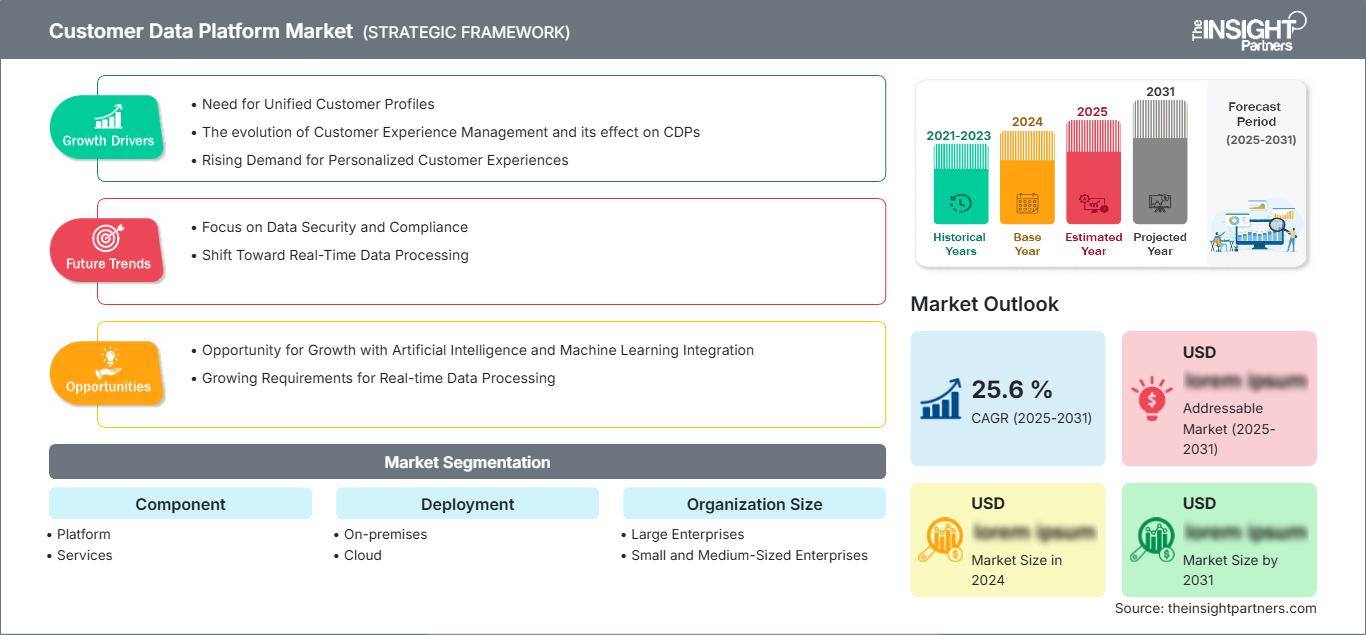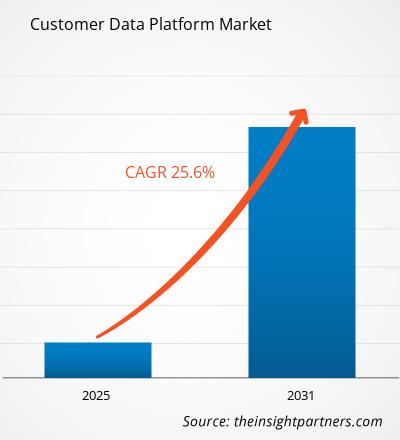Si prevede che il mercato delle piattaforme dati dei clienti registrerà un CAGR del 25,6% dal 2025 al 2031, con una dimensione del mercato in espansione da XX milioni di dollari nel 2024 a XX milioni di dollari entro il 2031.
Il rapporto è segmentato per componente (piattaforma, servizi); distribuzione (on-premise, cloud); dimensione dell'organizzazione (grandi imprese, piccole e medie imprese (PMI)); applicazione (raccomandazioni personalizzate, analisi predittiva, segmentazione dei dati di marketing, fidelizzazione e coinvolgimento dei clienti, gestione della sicurezza, altri). L'analisi globale è ulteriormente suddivisa a livello regionale e per i principali paesi. Il rapporto offre il valore in USD per l'analisi e i segmenti sopra indicati.
Scopo del rapporto
Il rapporto "Customer Data Platform Market" di The Insight Partners mira a descrivere il panorama attuale e la crescita futura, i principali fattori trainanti, le sfide e le opportunità. Ciò fornirà spunti a vari stakeholder aziendali, come:
- Fornitori/produttori di tecnologia: per comprendere le dinamiche di mercato in evoluzione e conoscere le potenziali opportunità di crescita, consentendo loro di prendere decisioni strategiche informate.
- Investitori: per condurre un'analisi completa delle tendenze in merito al tasso di crescita del mercato, alle proiezioni finanziarie del mercato e alle opportunità esistenti lungo la catena del valore.
- Organismi di regolamentazione: per regolamentare le politiche e le attività di controllo nel mercato con l'obiettivo di ridurre al minimo gli abusi, preservare la fiducia degli investitori e sostenere l'integrità e la stabilità del mercato.
Componente di segmentazione del mercato della piattaforma dati dei clienti
- Piattaforma
- Servizi
Distribuzione
- In sede
- Cloud
Dimensione dell'organizzazione
- Grandi imprese
- Piccole e medie imprese
Applicazione
- Raccomandazioni personalizzate
- Analisi predittiva
- Segmentazione dei dati di marketing
- Fidelizzazione e coinvolgimento dei clienti
- Gestione della sicurezza
Potrai personalizzare gratuitamente qualsiasi rapporto, comprese parti di questo rapporto, o analisi a livello di paese, pacchetto dati Excel, oltre a usufruire di grandi offerte e sconti per start-up e università
Mercato delle piattaforme di dati dei clienti: Approfondimenti strategici

-
Ottieni le principali tendenze chiave del mercato di questo rapporto.Questo campione GRATUITO includerà l'analisi dei dati, che vanno dalle tendenze di mercato alle stime e alle previsioni.
Fattori di crescita del mercato delle piattaforme dati cliente
- Necessità di profili cliente unificati: la crescita del mercato delle piattaforme dati cliente (CDP) dovuta alla crescente necessità di creare una visione unica dei dati dei clienti è esponenziale. Le organizzazioni adottano misure volte a raggruppare i dati dei clienti provenienti da settori verticali distinti per creare un profilo completo. Ciò consente loro di avere una visione olistica del cliente, che a sua volta migliora gli sforzi di marketing mirati e di personalizzazione. Nell'ottica di migliorare la soddisfazione del cliente, stanno diventando essenziali piattaforme dati cliente efficaci in grado di raccogliere e gestire diversi tipi di dati.
- L'evoluzione del Customer Experience Management e il suo effetto sulle CDP: con l'approccio incentrato sul cliente accolto e praticato dalle organizzazioni, le CDP iniziano ad acquisire importanza. Le organizzazioni acquistano sistemi progettati per raccogliere e analizzare i dati di interazione e soddisfazione dei clienti. In questa impresa, si affidano alle informazioni fornite dalle CDP, che offrono la comprensione degli utenti e consentono di creare offerte per gli utenti. L'esperienza del cliente, considerata più che mai come l'ultimo fattore nella competizione tra i player, spiega il tipico aumento della domanda di CDP.
- Crescente domanda di esperienze cliente personalizzate: poiché i clienti si aspettano interazioni più personalizzate con i brand, le aziende si concentrano sempre di più sull'offerta di esperienze su misura. Una Customer Data Platform (CDP) consente alle organizzazioni di aggregare, analizzare e utilizzare i dati dei clienti attraverso diversi punti di contatto per creare campagne di marketing, consigli sui prodotti e comunicazioni altamente personalizzate. Questa crescente domanda di personalizzazione sta guidando l'adozione di CDP in tutti i settori.
Trend futuri del mercato delle Customer Data Platform
- Focus sulla sicurezza dei dati e sulla conformità: alla luce delle attuali minacce alla protezione dei dati e alla riservatezza, si registra un aumento significativo dell'attenzione alla conformità nel settore delle CDP. Le organizzazioni stanno adottando misure per implementare solide misure di sicurezza che proteggano le informazioni dei clienti e rispettino la legge. Di conseguenza, si assiste all'emergere di CDP che vanno oltre i miglioramenti analitici e credono in una solida governance dei dati. Qualsiasi azienda in grado di dimostrare di prendersi cura dei dati attirerà la fiducia e la fedeltà dei consumatori, aumentando ulteriormente la propria quota di mercato.
- Passaggio all'elaborazione dei dati in tempo reale: l'elaborazione dei dati dei clienti in tempo reale è una tendenza emergente nel mercato delle CDP. Oggi i clienti si aspettano risposte immediate e interazioni personalizzate e le aziende si affidano sempre più a CDP in grado di elaborare e analizzare i dati in tempo reale. Questa tendenza spinge i fornitori di CDP a migliorare le capacità delle proprie piattaforme per gestire elevati volumi di dati a velocità elevata, consentendo alle aziende di offrire esperienze immediate e personalizzate e di rispondere immediatamente alle azioni dei clienti.
Opportunità di mercato per le piattaforme dati dei clienti
- Opportunità di crescita con l'integrazione di intelligenza artificiale e apprendimento automatico: l'applicazione dell'intelligenza artificiale e dell'apprendimento automatico all'interno delle piattaforme dati dei clienti (CDP) apre un mercato promettente per la crescita. Tali tecnologie possono aumentare le prestazioni delle CDP consentendo analisi di livello superiore, analisi predittive e scelte autonome. Inoltre, poiché le aziende cercano di ottenere un vantaggio competitivo attraverso l'uso dei dati, aumenterà l'interesse per le CDP che forniscono insight basati sull'intelligenza artificiale. Questa tendenza migliora le interazioni con i clienti, ma migliora anche l'efficienza delle attività di marketing, creando vantaggi per le aziende che la adottano.
- Crescente richiesta di elaborazione dati in tempo reale: la crescente importanza e la richiesta di elaborazione dati in tempo reale stanno aprendo nuove porte al mercato delle CDP. Le aziende sono leader, consapevoli della necessità di valutare e analizzare i dati dei clienti senza ritardi per adattarsi ai rapidi cambiamenti del mercato e dei consumatori stessi. Le CDP con funzionalità in tempo reale aiutano le organizzazioni a prendere decisioni più rapidamente, migliorandone così la velocità e la flessibilità. Con la crescente necessità di insight in tempo reale, le CDP in grado di offrirli saranno in una posizione migliore.
Mercato delle piattaforme di dati dei clienti
Le tendenze e i fattori regionali che hanno influenzato il mercato delle Customer Data Platform durante il periodo di previsione sono stati ampiamente spiegati dagli analisti di The Insight Partners. Questa sezione illustra anche i segmenti e la geografia del mercato delle Customer Data Platform in Nord America, Europa, Asia-Pacifico, Medio Oriente e Africa, America Meridionale e Centrale.
Ambito del rapporto di mercato sulla piattaforma dati dei clienti
| Attributo del rapporto | Dettagli |
|---|---|
| Dimensioni del mercato in 2024 | US$ XX million |
| Dimensioni del mercato per 2031 | US$ XX Million |
| CAGR globale (2025 - 2031) | 25.6 % |
| Dati storici | 2021-2023 |
| Periodo di previsione | 2025-2031 |
| Segmenti coperti |
By Componente
|
| Regioni e paesi coperti |
Nord America
|
| Leader di mercato e profili aziendali chiave |
|
Densità degli attori del mercato delle piattaforme dati dei clienti: comprendere il suo impatto sulle dinamiche aziendali
Il mercato delle piattaforme di dati dei clienti è in rapida crescita, trainato dalla crescente domanda degli utenti finali, dovuta a fattori quali l'evoluzione delle preferenze dei consumatori, i progressi tecnologici e una maggiore consapevolezza dei vantaggi del prodotto. Con l'aumento della domanda, le aziende stanno ampliando la propria offerta, innovando per soddisfare le esigenze dei consumatori e sfruttando le tendenze emergenti, alimentando ulteriormente la crescita del mercato.

- Ottieni il Mercato delle piattaforme di dati dei clienti Panoramica dei principali attori chiave
Punti di forza
- Copertura completa: il rapporto analizza in modo esaustivo prodotti, servizi, tipologie e utenti finali del mercato delle piattaforme dati dei clienti, offrendo una panoramica olistica.
- Analisi degli esperti: il rapporto è redatto sulla base della conoscenza approfondita di esperti e analisti del settore.
- Informazioni aggiornate: il rapporto garantisce la pertinenza aziendale grazie alla copertura di informazioni e tendenze dei dati recenti.
- Opzioni di personalizzazione: questo rapporto può essere personalizzato per soddisfare le esigenze specifiche del cliente e adattarsi in modo appropriato alle strategie aziendali.
Il rapporto di ricerca sul mercato delle piattaforme dati dei clienti può quindi contribuire a guidare il percorso di decodificazione e comprensione dello scenario del settore e delle prospettive di crescita. Sebbene possano esserci alcune valide preoccupazioni, i vantaggi complessivi di questo rapporto tendono a superare gli svantaggi.
- Analisi storica (2 anni), anno base, previsione (7 anni) con CAGR
- Analisi PEST e SWOT
- Valore/volume delle dimensioni del mercato - Globale, Regionale, Nazionale
- Industria e panorama competitivo
- Set di dati Excel
Report recenti
Rapporti correlati
Testimonianze
Motivo dell'acquisto
- Processo decisionale informato
- Comprensione delle dinamiche di mercato
- Analisi competitiva
- Analisi dei clienti
- Previsioni di mercato
- Mitigazione del rischio
- Pianificazione strategica
- Giustificazione degli investimenti
- Identificazione dei mercati emergenti
- Miglioramento delle strategie di marketing
- Aumento dell'efficienza operativa
- Allineamento alle tendenze normative






















 Ottieni un campione gratuito per - Mercato delle piattaforme di dati dei clienti
Ottieni un campione gratuito per - Mercato delle piattaforme di dati dei clienti